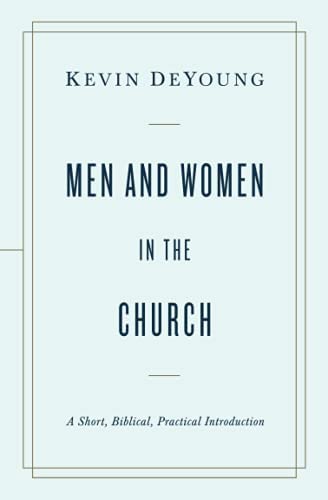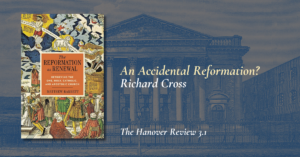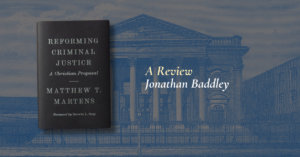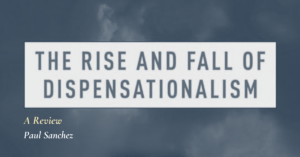DeYoung, Kevin. Men and Women in the Church. Wheaton, IL: Crossway, 2021. 176pp. Softcover. ISBN: 1433566532. $19.99.
1. Introducing DeYoung
Kevin DeYoung is the Senior Pastor of Christ Covenant Church in Matthews, NC, and Associate Professor of Systematic Theology at Reformed Theological Seminary (Charlotte, NC). He also serves as a council member of The Gospel Coalition (TGC). He earned his PhD at the University of Leicester and has authored numerous books, including What Does the Bible Really Teach About Homosexuality? with Crossway in 2015. This is his third published foray into issues of sexuality. DeYoung is also well known for his prolific blog at TGC where he has authored numerous articles related to the topic.
2. Summarizing the Book
The book now under consideration, Men and Women in the Church, clocks in at roughly 120 pages of main text and is designed to be a very brief introduction to the topic for interested laypersons, elders, deacons, and trustees (16). As DeYoung suggests, think of a book that would be found in your church’s “book nook” or library. That’s what this is supposed to be. It isn’t designed to be a comprehensive guide to the exegetical, theological, and practical aspects of complementarianism. It is designed to be a high-level introduction for those not familiar with the lay of the land. It is important to keep this goal in mind to properly evaluate the success of the book because those searching for a monograph-level treatment will be disappointed.
DeYoung’s thesis is that “God’s design is for men to lead, serve, and protect, and that, in the church, women can thrive under this leadership as they too labor with biblical faithfulness and fidelity according to the wisdom and beauty of God’s created order” (19). To defend this thesis, DeYoung carves the book into two parts, with the first taking the lion’s share of the ink—the first section being the “biblical exploration.” He begins with a chapter on Genesis, offering fifteen observations from the creation account that relate to manhood and womanhood. These range from basic claims that both men and women are created in the image of God to marriage entailing that the man leaves his parents. All of them are, however, largely traditional. He takes each of them to be “divine patterns and assumptions.” Therefore, they are not “ironclad constraints” (33).
DeYoung does make several interesting claims among these fifteen observations that are worthy of notation. First, DeYoung argues that man and woman were given different tasks in creation and “created in different realms” (26). DeYoung argues that since Adam was created outside the garden, he was charged with cultivating and protecting it, whereas since Eve was created inside the garden, she was charged with tending to the communal aspects. DeYoung further grounds this in the man’s greater biological strength that is more fitted to this task and the woman’s capacity to create new life that is more fitted to her task. Second, in similar fashion, DeYoung argues that since man and woman were created in different ways, their tasks correspond with their creation. Since man was created from the ground, he is tasked with tending to it. Since woman was created from man, she is tasked with tending to him (29). Third, DeYoung argues that the man alone was given a “priest-like task of maintaining holiness in the garden” because he alone was given the command to not eat of the tree of knowledge of good and evil (27).
The second chapter provides five patterns from the Old Testament for manhood and womanhood. These include (1) Only men exercising official leadership (2) Godly women displaying a wide range of heroic characteristics (3) Godly women helping men (4) Ungodly women influencing men for evil, ungodly men mistreating women (5) Women finding pain and purpose associated with bearing and caring for children. The third chapter briefly surveys the gospels in less than five full pages.
The fourth chapter begins critical engagement with more challenging biblical texts, this one focusing on 1 Corinthians 11:2-16 and 14:33-35. The next three chapters (5-7) follow this pattern, exegeting Ephesians 5:22-33, 1 Timothy 2:8-15, and 1 Timothy 3:1-13. In chapter seven, DeYoung argues against women deacons on grounds of ordination. Essentially, because of the authority inherent in a church office, women should not be deacons. However, he permits all the diaconal tasks for women—he simply suggests they should not hold the office (93).
Part two begins in chapter eight, covering the most common objections to complementarianism, such as Galatians 3:28, slavery, women in ministry in the Bible, etc. Chapter nine is DeYoung’s attempt to elucidate the important sexual differences. What does it mean to be a man or woman? He explains this through five key areas: Appearance, Body, Character, Demeanor, and Eager posture. DeYoung examines each of these with various scriptural texts. For example, on the topic of body, DeYoung begins with Leviticus 18:22 which says, “You shall not lie with a male as with a woman; it is an abomination.” From this, he argues that biological sex is normative (120). On the topic of demeanor, he provides 1 Thessalonians 2:7-8 and 2:11-12 as the primary proof texts. He suggests that Saint Paul identifies various demeanors with one gender more than the other (125). This doesn’t mean that the virtues are exclusively feminine or masculine but that some “fall naturally along gender lines” (126). The tenth chapter is a brief exposition of why men and women are different. DeYoung argues that we should follow Christ as men and follow Christ as women (132). Similarly, there is something about the marriage relationship that shows everyone what sort of people men and women are supposed to be (136). DeYoung concludes with a short appendix on whether you should allow a woman to give the Sunday sermon.
3. Critical Interaction
Given this rough summary, my intent is to critically interact with DeYoung. I am a firm believer in serious critique as the pathway to stronger and healthier doctrine. And to be honest, I don’t find book reviews that are mere summaries to be all that helpful. I can go look at a table of contents and the back cover of a book to get that information. I like to wrestle with ideas. And I think that’s the greatest benefit of a critical book review. Whether one agrees with the content of the book or not is less important. It’s the process of examining whether the book itself makes a compelling case or not that is valuable. So, while I largely agree with DeYoung, I do find several areas of deficiency throughout his book worth highlighting. I think working through these will help us to think well about the topic. I will designate these as “concerns” rather than problems since I do fundamentally agree with DeYoung and don’t find any of these deficiencies as destructive of his overall viewpoint. Arguments, articles, and books can all be right in their fundamental assertions and yet wrong in how they go about defending them.
First, while the book is designed to be a short introduction that doesn’t get bogged down in the gritty details, there remain places wherein it feels both overly technical and quick. For example, DeYoung’s explanation of authentein (the Greek word for “to exercise authority”) includes quite technical material in dense fashion that doesn’t allow the typical lay reader to grasp what is going on. DeYoung immediately begins by showing the various translations and the syntax of the phrase (e.g. “(1) a negated finite verb + (2) infinitive +….”) (81-83). While this information is no doubt important, the lay reader needs far more guidance into matters such as translation and Greek syntax. Elsewhere, in his common objections section, certain crucial objections to his overall view (complementarianism) receive only a paragraph of explanation, such as Junia and female prophetesses. I think most readers would benefit from slightly more explanation on these important areas. But I do understand the nature of the work is to be short and readable, so some difficult decisions to cut material must be made. This of course is a double-edged sword. Short books are both a vice and a virtue. They are a virtue because they can appeal to nearly any audience. But they are a vice because much of the crucial debate can be compressed and overly simplistic.
A second area of concern relates to the level of importance he attaches to this discussion. I am uncomfortable affirming with DeYoung that what is at stake with God making us male and female is “nothing less than the gospel” (14). He says that “any move to abolish all distinctions between men and women is a move (whether intentionally or not) to tear down the building blocks of redemption itself” (14). The reason I am troubled by this is that his thesis is designed to defend complementarianism primarily. If this is true, he seems to be suggesting that egalitarianism loses the gospel in some respect. I simply do not see how this follows. One could affirm women elders and be wrong, but not lose the gospel. I fear that attaching such weight to this topic is counterproductive and often leads people to alternative conclusions not because of biblical, theological, or philosophical arguments, but because of existential dissonance. Now, if DeYoung means the more general claim regarding affirming the distinctions in biological sex, his claim can have more weight, but even then, I am not convinced that sexuality is a “first-tier” doctrinal issue. It is no doubt important and doubly so from a pragmatic perspective (e.g. if I think I can change my biological sex, that will have far more “real world” impact on my life than affirming something like Arianism). But I don’t think it should be given gospel importance. I think it is crucial that we keep the gospel clear and distinct as the message of Christ’s redemption and not a message about all the social implications that the gospel has. The social implications are biblical and important but not fundamental to the core gospel message of knowing Christ crucified and risen.
A third concern is that DeYoung is regularly ambiguous or unclear with many of his assertions. Some of this is due to the goal of the book to be both short and biblical. So, he doesn’t cover various theological or philosophical topics that I’d like to see addressed. But I’ll show two quick examples of what I mean. First, DeYoung asserts that the “connection between biological sex and gender is routinely rejected” (132). This is a true assertion. But nowhere does DeYoung explain what this connection is. It is simply vaguely asserted that a connection exists and that it justifies complementarianism. Second, DeYoung says, “I think Paul allows us to employ our own cultural cues of manhood and womanhood” (57). This is an oddly unclear assertion. What if our culture is anti-Christian? Should I look to a culture that is dominated by LGBTQ+ thinking? I think the answer is quite obvious. Moreover, it isn’t clear why we should assume cultural cues (even Christian ones) should guide us. Maybe they should, but DeYoung offers no explanation.
A fourth concern is a seeming over-emphasis on the submissive role of women. Now, I am a complementarian in the sense that men should lead in the home and the office of elder is restricted to men. Therefore, I agree with the big ideas that DeYoung is arguing for. However, he oftentimes ends up focusing on women’s “helping” and “submission” to the neglect of the corresponding duty for men. For example, in chapter two on “patterns that preach,” pattern three is “godly women helping men” (39-40). However, there is no mention of what men are to do. And it seems rather basic that men should help women too. Consider also pattern number five: “Women Finding Pain and Purpose Associated with Bearing and Caring for Children.” But there is no explanation of the man’s role. If left to our own interpretive devices, it appears that caring for children is exclusively the domain of the woman. Or consider the odd claim from DeYoung that the man alone was given a “priest-like task of maintaining holiness in the garden” because he alone was given the command to not eat of the tree of knowledge of good and evil (27). This assertion is rather strange to me. Does Scripture not treat the entire nation of Israel, and by extension the church, as a kingdom of priests? What does Adam’s reception of the command prior to Eve’s creation have to do with priesthood? All the connections here are quite fuzzy to me. Of course, as I’ve mentioned several times, this very well could be due to the size of the book. But even so, I mention it because I do find it confusing at times.
Now, despite these concerns, I think DeYoung has offered a fine primer on the topic from a complementarian perspective. I’ll offer several reasons for this conclusion. First, while he has some idiosyncrasies, he is free from some of the larger foibles of the contemporary conservative complementarian movement, such as Eternal Functional Subordination and overly arbitrary commands such as men not taking geographical directions from women. Second, he notes most of the big biblical issues at play, which ought to help the lay reader who is wanting a basic guidebook for what complementarianism is. All the major texts are brought forth and explained, at least at a very high level. Third, it is not overly polemical. DeYoung set out to treat others with fairness, honesty, and respect (19). I think he does a marvelous job of this. Despite my hesitation regarding his usage of complementarianism being a gospel issue, overall, he is polite and never combative. The tone of the book is warm and generous. These marks ought to be commended, especially given the serious heat around the topic in contemporary culture.
4. Conclusion
So, is it worth buying and reading Men and Women in the Church? To answer this question, I want to consider whether DeYoung has succeeded in his goal. Again, DeYoung’s thesis is that “God’s design is for men to lead, serve, and protect, and that, in the church, women can thrive under this leadership as they too labor with biblical faithfulness and fidelity according to the wisdom and beauty of God’s created order” (19). And he has written to a lay audience. From a purely explanatory view, I think DeYoung has achieved his goal. He provides a short introduction to the main biblical texts and offers a few short practical explanations of how it all cashes out. However, DeYoung’s thesis was intended to convince and persuade rather than merely inform (19). From this perspective, I think DeYoung has not succeeded. He would either need to have significantly expanded the length of the book to offer a substantial defense of complementarianism or remove several chapters and focus on the key biblical texts (from his perspective) to allow for a full defense and treatment. So, do I recommend it? I think so, depending on your context. If your church is complementarian, and you have lay church members wanting to understand the biblical rationale for complementarianism, it is a good resource. However, it does not go much further than that. It does not engage questions of gender, sexuality, or the broader theological and philosophical rationale for such views. Thus, I don’t think this is the best resource for deacons or elders. There are thicker treatments that would be more useful for them. I also think if your church member is not complementarian, it is best to start with something else more rigorous.
Editors Note: The London Lyceum publishes a range of original pieces and book reviews from various faith traditions and viewpoints. It is not the mission of the London Lyceum to always publish work that agrees with our confession of faith. Therefore, the thoughts within the articles and reviews may or may not reflect our confessional commitments and are the opinions of the author alone. Rather, we seek to generate thinking and foster an intellectual culture of charity, curiosity, critical thinking, and cheerful confessionalism.
Author
-

Jordan L. Steffaniak (ThM, Southeastern Baptist Theological Seminary) is President of the London Lyceum and Publisher for Hanover Press. He is a Research Fellow for the Center for Faith and Culture at Southeastern Baptist Theological Seminary, a PhD candidate in Philosophy at the University of Birmingham, UK, and teaches at various institutions. He has a wonderful wife and three sons. He also works in the financial industry as a business intelligence manager.
Recent Posts



